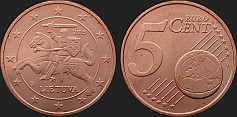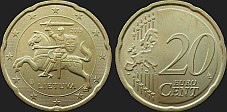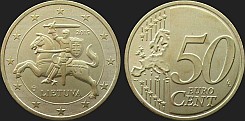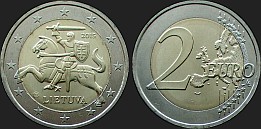LITHUANIA (from 2015) - Lithuanian euro coins [EUR]
1 euro = 100 euro cent
The preparations for the monetary union started in 1991 in Maastricht. In December 1995 in Madrid the name of the new currency was chosen. On January 1st, 1999 Euro [EUR] became an official (although virtual) currency in 11 countries of the European Union (Austria, Belgium, Finland, France, Germany, Ireland, Italy, Luxembourg, the Netherlands, Portugal and Spain). In 2001 Greece also joined the system. The first coins were minted already in 1999, but real money entered circulation only on January 1, 2002. The Eurozone was extended six times: in 2007 (Slovenia), 2008 (Cyprus and Malta), 2009 (Slovakia), 2011 (Estonia), 2014 (Latvia) and 2015 (Lithuania). Thus 19 countries belong to the eurozone today. Euro coins are also being issued by four small countries, which do not belong to the EU, but signed a special agreement with the EU: Andorra, Monaco, San Marino, and Vatican. Euro is the official currency also in Montenegro, Kosovo, and French overseas regions. About 340 millions of people use Euro everyday.
The common side, identical for all of the Euro issuers was chosen in a graphic competition won by Luc Luycx. On June 7, 2005 it was decided to change the design of the common side of euro coins. Coins with face values 10, 20 and 50 cents as well as 1 and 2 euros issued after January 1, 2007 show a full map of Europe without political borders. Coins issued by Italy (including San Marino and Vatican), Austria and Portugal implemented the change only for coins issued in 2008. By the decision of the European Central Bank any euro coin issued after January 1, 2009 must bear the new reverse. Eurozone members may choose any motif for their national side as long as it contains a ring of twelve stars at the edge and the name or symbol of the issuing country.
The design of the national side of the Lithuanian euro coins was based on public opinion survey made by the Central Bank of Lithuania. The public was supposedly clearly in favor of the Coat of Arms of Lithuania to be the theme on each of the denominations and the only issue remaining was a detailed design of it and its neighbourhood. In 2004 the central bank announced an art competition for the design of national obverse. Among the proposals of 14 artists the project of current designer of Lithuanian litas coins - Antanas Žukauskas was selected. In 2007, Lithuania was already one foot in the euro zone and even produced a trial series of euro coins, but the required inflation rate was exceeded by Lithuania and joining the zone was postponed. On July 23, 2014, the Council of the European Union approved eventually the introduction of the euro in Lithuania and one day later Lithuania started producing coins with year of issue 2015 on the obverse. Euro replaced the Lithuanian currency - litas [LTL] on January 1, 2015. The exchange rate was established already on February 2, 2002 at 1 [EUR] = 3.4528 [LTL]. Coins and banknotes of the Lithuanian litas may be exchanged into euros in the branches of the central bank without time limits.
coins catalogue :: katalog monet :: münzkatalog :: catalogue de monnaies :: catálogo de monedas :: catalogo monete :: каталог монет :: κέρματα κατάλογος :: COINZ.eu
© 2010-2025 :: Adam Kubicki :: COINZ.eu :: All rights reserved.










